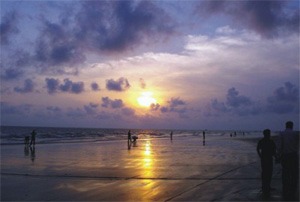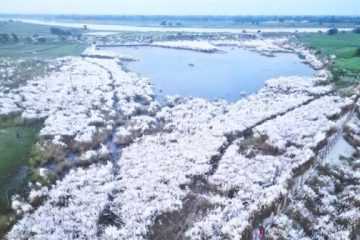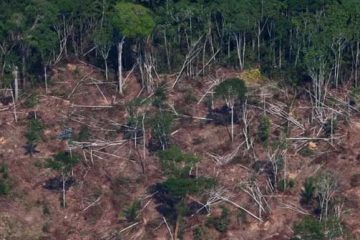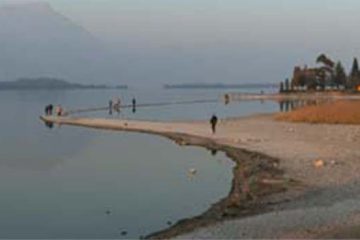Kuakata Biodiversity
How will it respond to predicted climate change?
Dr. Md. Mizanur Rahman
 KUAKATA, locally known as Sagar Kannya (daughter of the sea) is located in the southwest of Bangladesh. Next to Cox’s Bazar it is the second most famous sea beach of this country. And Kuakata is one of the rarest sea beaches of the world, which has a rare scenic beauty offering the full view of the rising and setting of crimson sun in the water of the Bay of Bengal. This 30 km long and 03 km wide beach has a typical natural setting and sandy as gently sloping into the Bay of Bengal.
KUAKATA, locally known as Sagar Kannya (daughter of the sea) is located in the southwest of Bangladesh. Next to Cox’s Bazar it is the second most famous sea beach of this country. And Kuakata is one of the rarest sea beaches of the world, which has a rare scenic beauty offering the full view of the rising and setting of crimson sun in the water of the Bay of Bengal. This 30 km long and 03 km wide beach has a typical natural setting and sandy as gently sloping into the Bay of Bengal.
It is 70 km away from Patuakhali district headquarters and 320 km from the capital Dhaka. The sight is characterised by an excellent combination of eye-catching natural beauty, sandy beach, blue sky, huge expanse of water of the Bay and evergreen forest. The unique customs of the ‘Rakhyne’ tribal families and Buddhist temple of about hundred years old indicate the ancient tradition and cultural heritage in the area.
Kuakata is a unique example of co-occurrence of different ecosystems. There are remnants of mangroves in this beach. The line of coconut trees has increased the scenic beauty of this seashore. The nearby Fatra and Gangamati mangrove forests (part of Sundarbans) have enriched the biodiversity of this territory. The tamarisk (Jhou) forests have added more attraction to this beach.
There are uneven and mixed patches of trees dominated by Keora and Gewa. The pioneer species Shundari trees are occasionally distributed in these forests. Gola (firewood) and Hantol are the indicator plant species of these ecosystems. Kakra and Pashur have become rare species though they were abundant few decades back. Sporadic patches of Hogla (a robust herb) and Golpata exist throughout the area. The plant species composition differs greatly within the forests and the canopy closure is a mosaic.
The forests are characterized by several small patches of mature trees, shrub-lands, isolated old trees and denuded sands. These forests are habitats of rhesus monkey, wild boar, spotted deer, snakes, forest owl, fox, wild fowl and lizards. Mangroves as well as the beach are the home to turtles, molluscs, crabs, sea weeds and sea birds, and provide excellent nurseries for marine fishes like Hilsha, Hamilton (Baila), Asian Sea Bass (Koral), Black Sea Bass (Bhol Koral), Silver Pomfret (Ruupchanda), dolphins and shrimps.
Kuakata is a virgin abode of migratory winter birds. It is the home of Cotton Pygmy-goose, White-winged duck, Sarus crane, Eurasian Thick-knee, Indian Cormorant, White-bellied heron, Pacific Reef Egret, Malayan Night heron, Glossy Ibis, Woolly-necked stork, Asian Openbill, Indian Pond heron, Black-bellied Tern, Gull-billed Tern, Spot-billed duck, Lesser Whistling-duck, Watercock, etc. Migratory birds like Common Shelduck, Ruddy Turnstone, Sanderling, Great Knot, Long-billed Ringed Plover, Crab Plover, Caspian Tern, Spot-billed Pelican, White Stork, etc. come in winter from the temperate regions.
The climate change has already affected the coastal ecosystems of the northern hemisphere. This is also a region of transition between the freshwater of the rivers (Payra, Bishkhali and Agunmukha) and the saline water of the Bay of Bengal.
The luxuriant biodiversity of Kuakata region has strong interactions with marine environment. The environmental parameters with the direct influences on mangroves (Fatra and Gangamati forests), Coconut orchards, Jhau Bans and the beach in terms of global climate change are sea-level rise, cyclones, rise in temperature and salinity.
The species composition of Fatra and Gangamati forets may undergo major change, depending on the severity of predicted climate change impact.
Sea level rise, increased salinity and inundation will change the forest’s nature. One-metre rise of sea level will destroy the whole ecosystem. Shrub-land and dune vegetation will be submerged. The occasionally distributed pioneer species Sundari will be totally replaced by Keora and Gewa. The mixed stands will be converted into pure stands and old grown forests will be changed into new successional forests. Sundari, Kakra and Pashur will be highly vulnerable even in low level sea rise (8-9cm/100 years) while, they will be extinct from these ecosystems in medium level sea rise (9-12cm/100 years).
Keora and Gewa will be able to keep pace with low level sea rise. In high level sea rise (>9-12cm/100 years) all existing plant species will be lost except aquatic plants. The repetition of cyclones like Sidr and Aila will degrade the habitats and the affected forests will be unsuitable for natural regeneration. Sediments carried by storm surges will cause plants mortality by interfering with root and soil gas exchange. Alien exotic plant species will be rapidly suppressing native flora.
Coconut palm will be highly affected by high temperature. Pollen viability will be reduced with the increase of temperature affecting reproductive development. Deformation of fruits will occur resulting in small number of nuts, empty nuts or elongated nuts.
Predicted climate change will be congenial for Jhau but the introduction of invasive species may cause local decline, and even extinction of tamarisk. Invasive species will change community composition and ecosystem functioning.
The monkey, spotted deer, wild boar, fox and lizards will face shortage of foods. They, often in groups will move to the locality by swimming rivers and canals for foraging foods and sweet water. Many of them will die of drowning or caught by crocodiles and the people.
Most of the fish species and shrimps utilize fresh water for spawning and juvenile feeding. The Hilsa needs sweet water to lay their eggs and the hatchlings move towards marine water where they attain adulthood. The breeding habitat of most of the fish species and other crustaceans will be destroyed with the intrusion of salinity. The migration of certain fish species out of their natural habitats will cause food shortages for thousands of people.
Forty percent of algae population may die due to climate change by the end of this century (Muller 2009). Sea-level rise will cause erosion of turtle nesting beaches. Higher sand temperature will lead to changes in sex ratios or prevent eggs from hatching. Huge rainfall may raise ground water tables, thereby flooding nests of turtles. Sea acidification will decline the abundance of mollusc. The breeding place of crabs and shrimps will be destroyed due to sea level rise.
The plant parts of Fatra and Gangamati mangrove vegetations provide nourishment for young fish, shrimps, and crabs. In the changed environment, only a handful would survive. Mangrove trees also provide habitats to young fish, shrimps, crabs and molluscs. The mangrove trees provide not only support to countless food webs; they are also indirectly responsible for the survival of the most primary planktonic and epiphytic algal food chains. High salt concentration will make the ecosystem unfavourable for most of the species.
Ground birds will be severely affected by losing their habitats, nesting and breeding sites. High sea temperature will affect seabirds’ foraging success, growth patterns and reproductive potentiality. Over all global warming will affect the abundance and spatial distribution of birds. Cyclones will cause large-scale mortality of adults, exposure of eggs and young, starvation or structural failure of nests. Climate change will affect the abundance and availability of food (i.e., arthropods) which influence nestling survival and the frequency of double-brooding and hence seasonal fecundity.
How to mitigate
o Monitoring of biological resources and impact of climate change to adopt appropriate biodiversity management
o Emphasising on adaptive or community based conservation programme
o Combining adaptation and mitigation measures
o Planned adaptation options to climate change will consider three approaches namely planned retreat, accommodation, and protection
o Developing alternative livelihoods for the fishermen
o Initiating conservation programme for the migratory birds
o Declaring the Fatra and Gangamati mangroves as natural forest reserves
o Protecting natural regeneration to promote natural succession in the denuded lands Fatra and Gangamati mangroves
o Creating of public awareness
o Strengthening research work on the impact of climate change
o Emphasising on ex-situ conservation of occasional and rare species like Sundari, Pashur and Kakra
o Establishing an information system of biodiversity
o Raising funds for conservation programme
o Restoring and maintaining mangroves to minimise erosion
o Designing and establishing sea-level / climate modelling network
o Establishing database systems for biological resources
o Integrated coastal and marine management
o Assessing coastal vulnerability and risk to climate change
o Increasing waterfront setbacks in beach front areas
o Education on climate change and emergency preparedness at all levels
o Developing coastal infrastructure
o Protecting existing mangroves against encroachment and cutting
o Afforestation and reforestation by salt tolerant species like Gewa and Keora
o Establishing mechanisms to promote carbon uptake
o Digging out thickets of invasive plant species from the Jhau forests
o Gap filling by native species in the Jhau forests and mangroves to protect invasion by exotic species
Dr. Md. Mizanur Rahman, a biodiversity specialist, is Assistant Commissioner, Jhalakathi Collectorate. E-mail: mizan_peroj @yahoo.com





